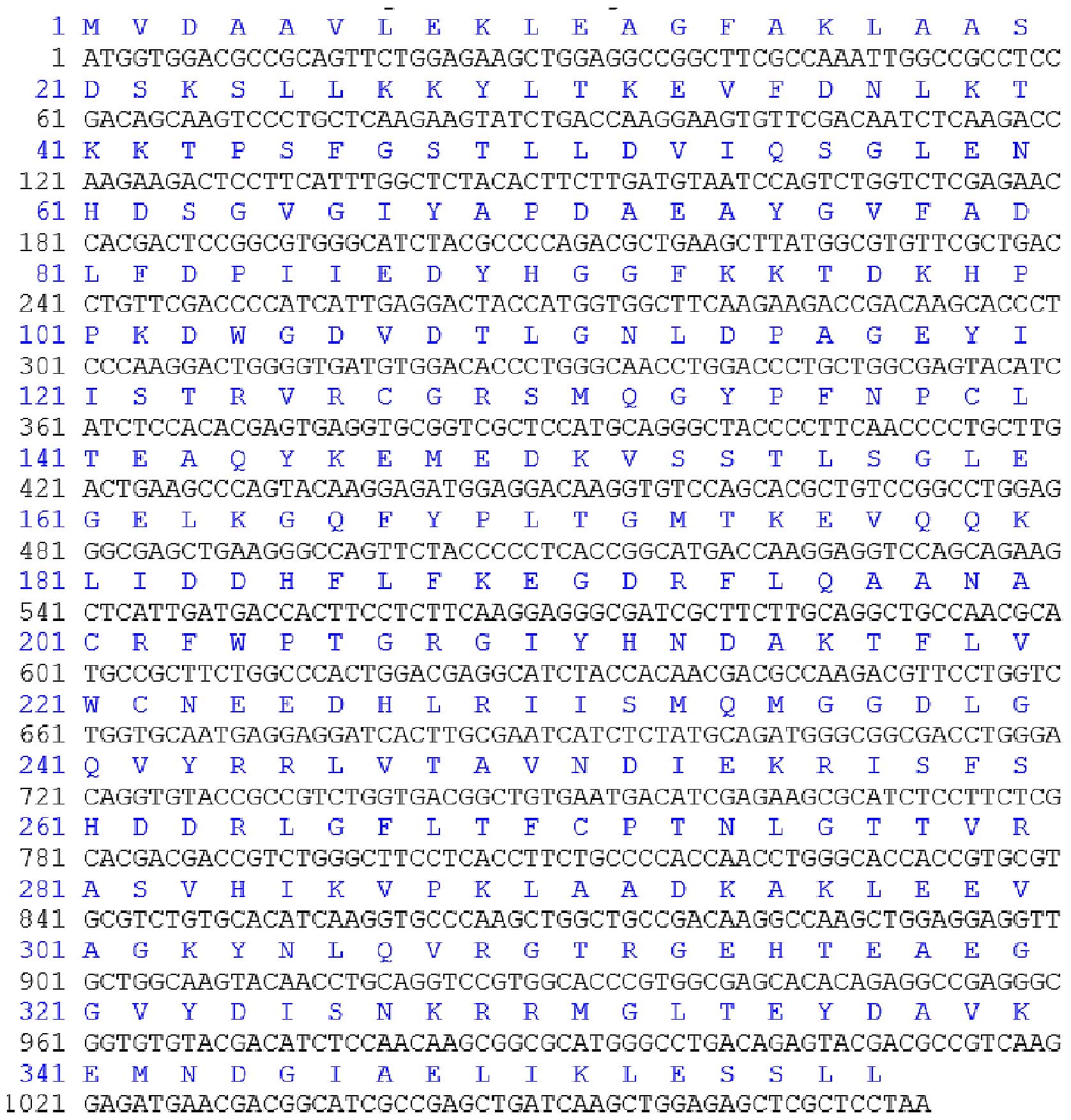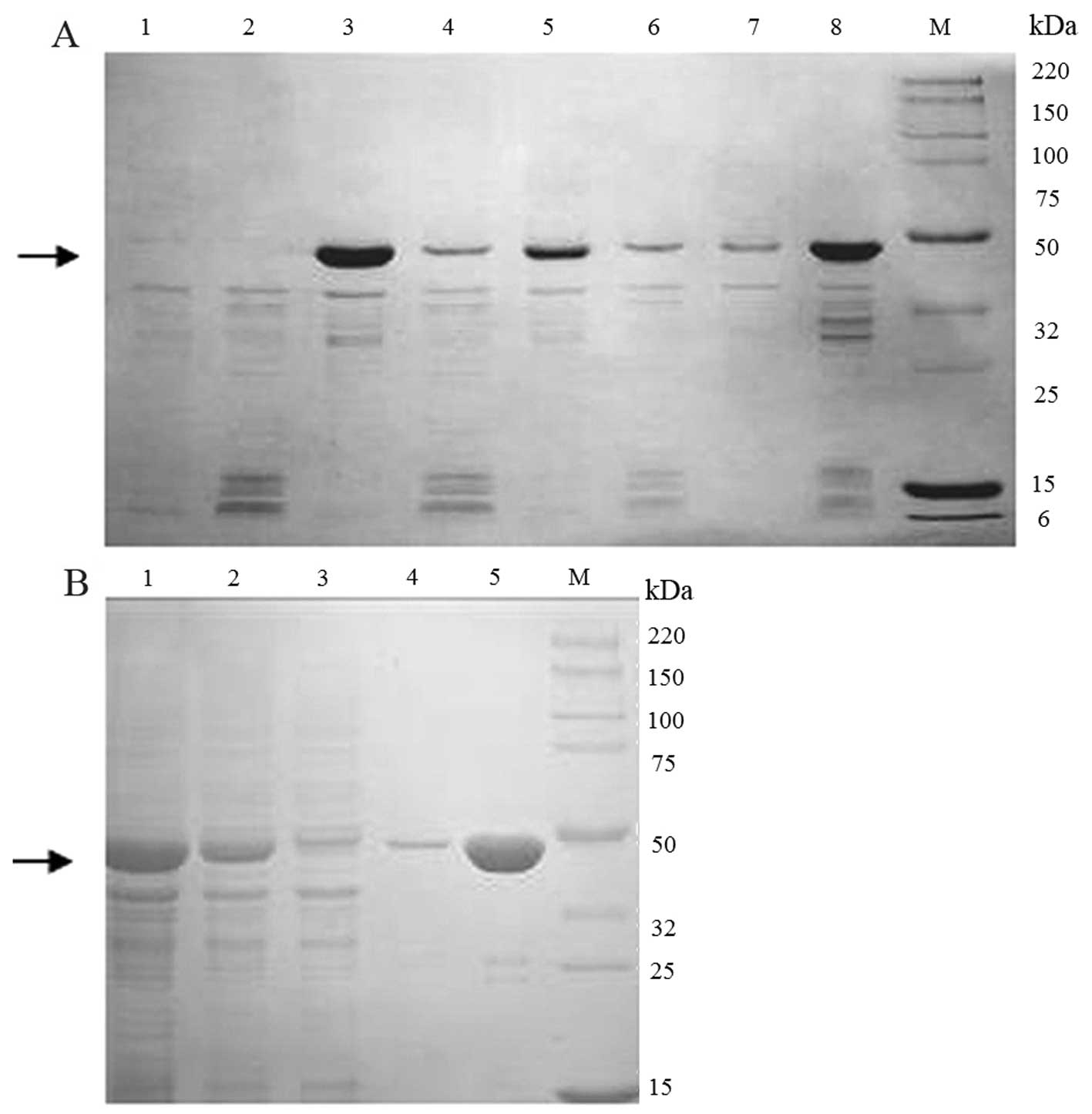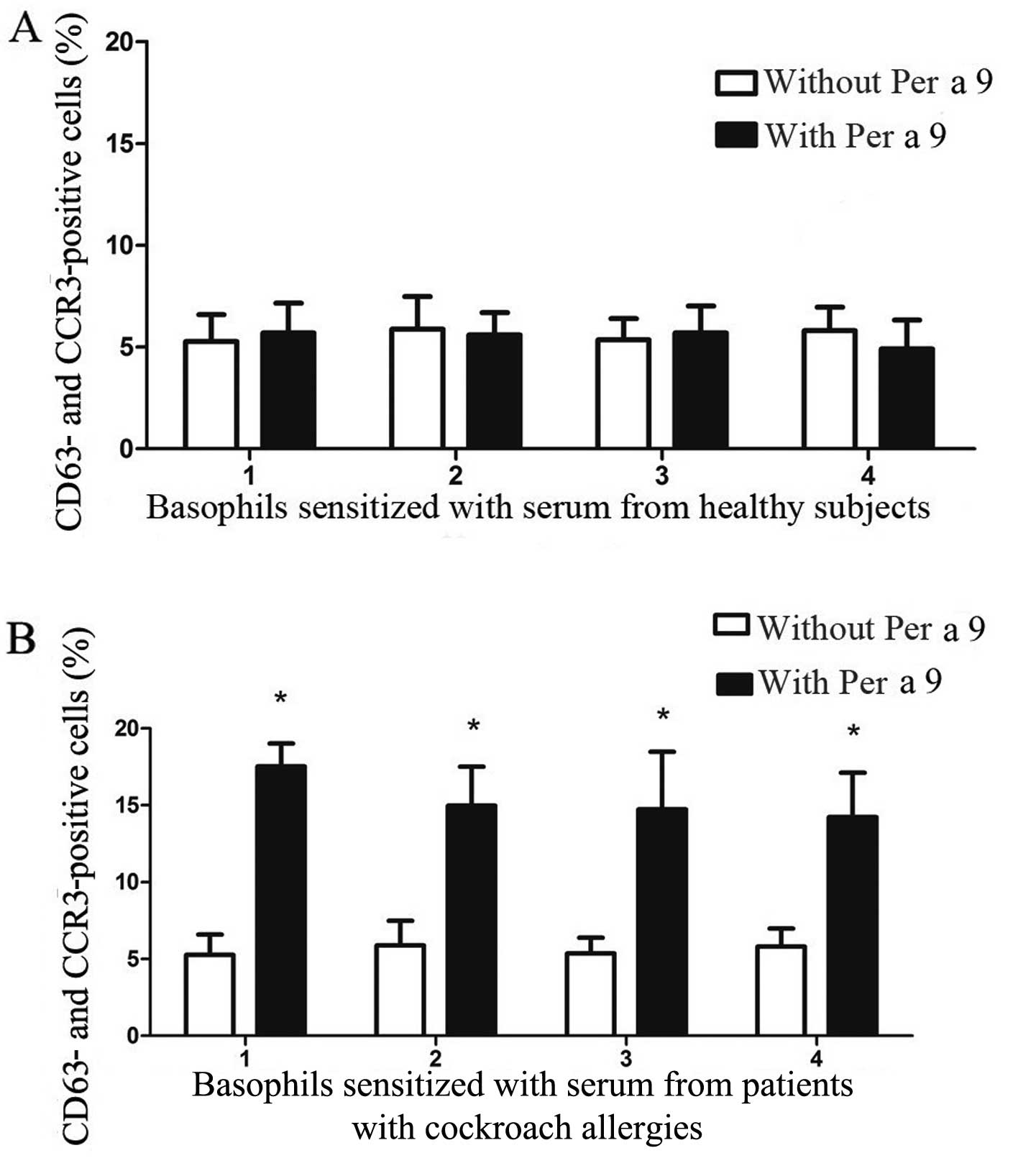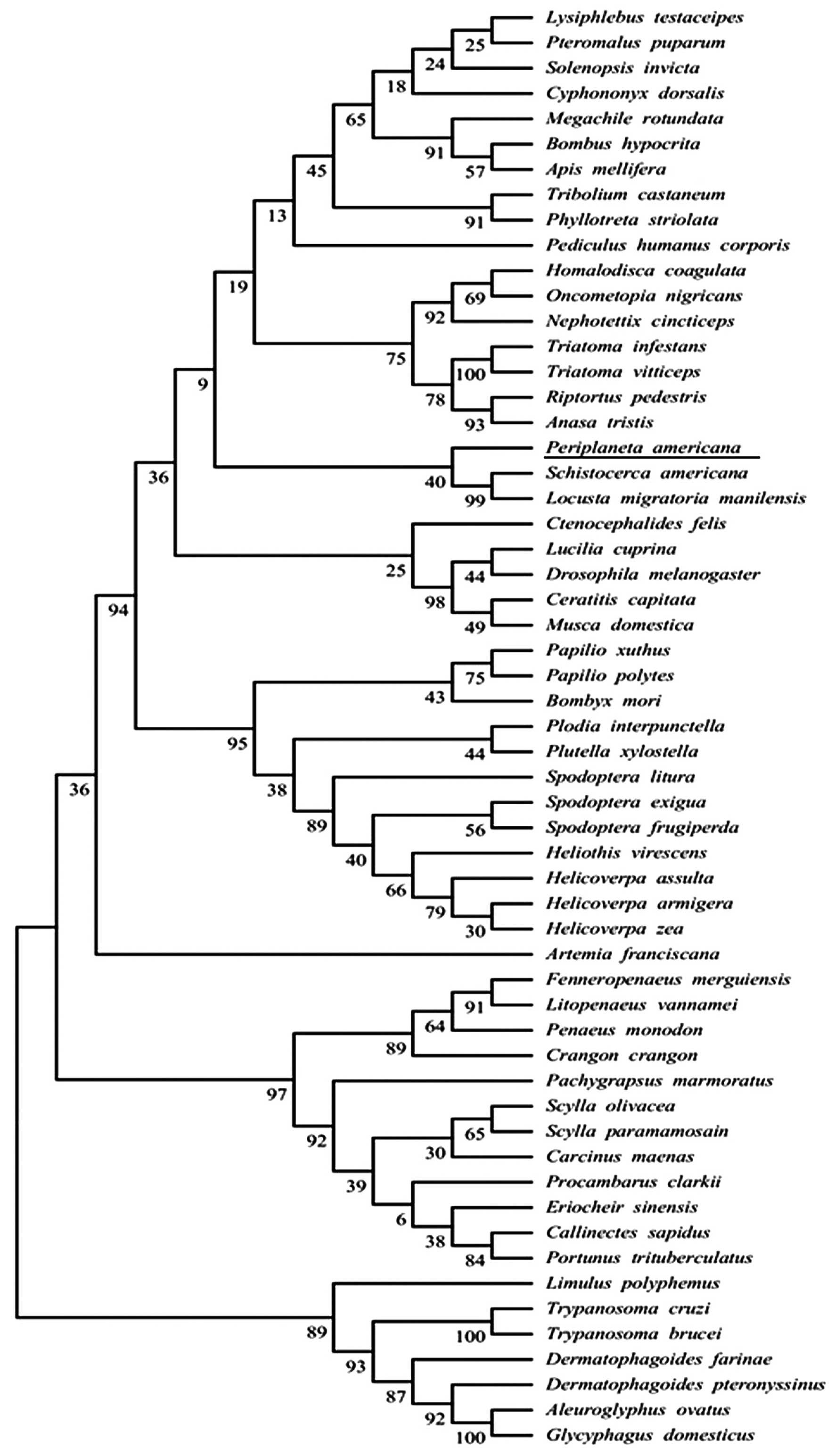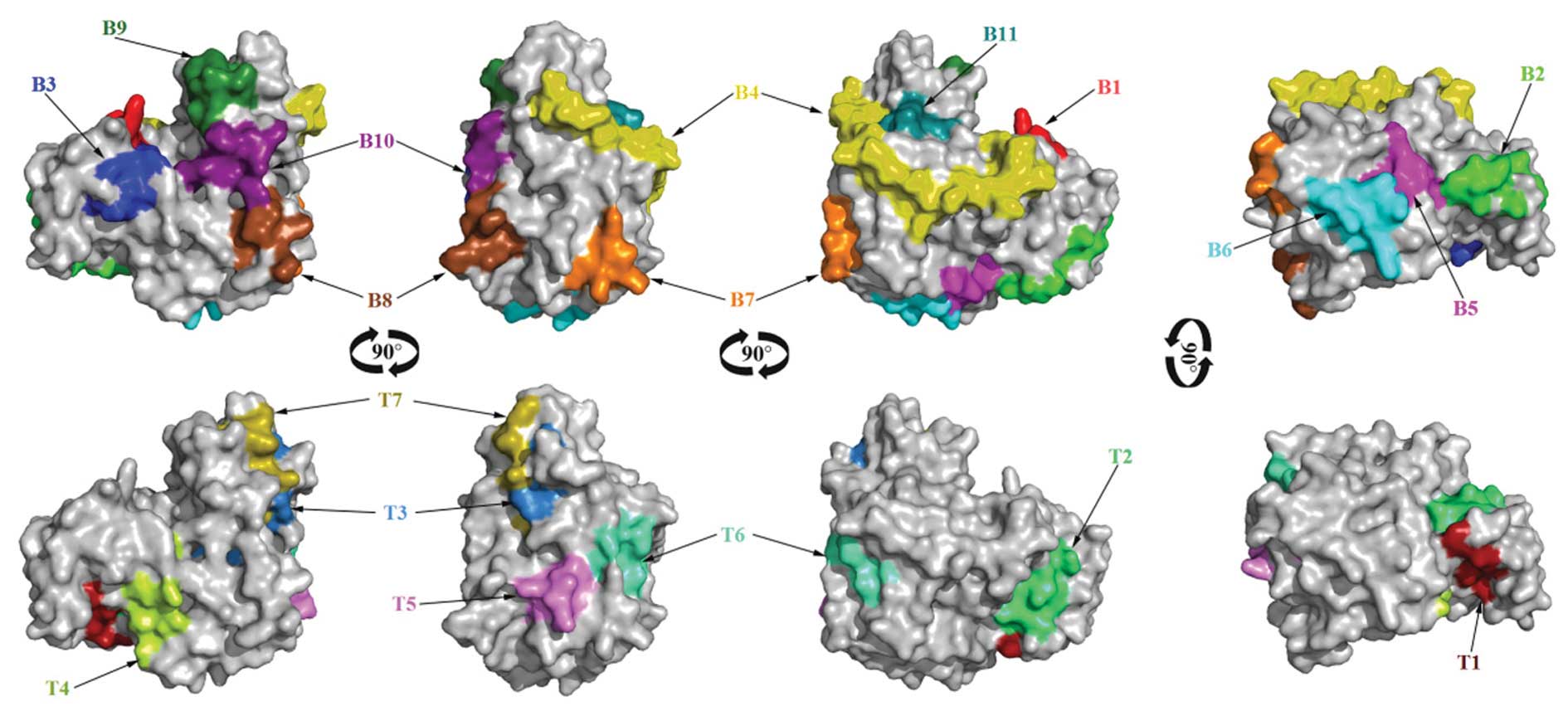|
1
|
Bernton HS and Brown H: Insect allergy
preliminary studies of the cockroach. J Allergy. 35:506–513. 1964.
View Article : Google Scholar : PubMed/NCBI
|
|
2
|
Arruda LK, Vailes LD, Ferriani VPL, Santos
AB, Pomés A and Chapman MD: Cockroach allergens and asthma. J
Allergy Clin Immunol. 107:419–428. 2001. View Article : Google Scholar : PubMed/NCBI
|
|
3
|
Sun BQ, Lai XX, Gjesing B, Spangfort MD
and Zhong NS: Prevalence of sensitivity to cockroach allergens and
IgE cross-reactivity between cockroach and house dust mite
allergens in Chinese patients with allergic rhinitis and asthma.
Chin Med J (Engl). 123:3540–3544. 2010.
|
|
4
|
Thangam Sudha V, Arora N, Sridhara S, Gaur
SN and Singh BP: Biopotency and identification of allergenic
proteins in Periplaneta americana extract for clinical
applications. Biologicals. 35:131–137. 2007. View Article : Google Scholar
|
|
5
|
He S, Zhang Z, Zhang H, Wei J, Yang L,
Yang H, Sun W, Zeng X and Yang P: Analysis of properties and
proinflammatory functions of cockroach allergens Per a 1.01s. Scand
J Immunol. 74:288–295. 2011. View Article : Google Scholar : PubMed/NCBI
|
|
6
|
Wu HQ, Liu ZG, Ran PX, Zhou ZW and Gao B:
Expression, purification, and immunological characterization of Cr
PI. Protein Pept Lett. 14:881–885. 2007. View Article : Google Scholar : PubMed/NCBI
|
|
7
|
Mindykowski B, Jaenicke E, Tenzer S, Cirak
S, Schweikardt T, Schild H and Decker H: Cockroach allergens Per a
3 are oligomers. Dev Comp Immunol. 34:722–733. 2010. View Article : Google Scholar : PubMed/NCBI
|
|
8
|
Tan YW, Chan SL, Ong TC, Yit Y, Tiong YS,
Chew FT, Sivaraman J and Mok YK: Structures of two major allergens,
Bla g 4 and Per a 4, from cockroaches and their IgE binding
epitopes. J Biol Chem. 284:3148–3157. 2009. View Article : Google Scholar
|
|
9
|
Wei JF, Yang H, Li D, Gao P and He S:
Preparation and identification of Per a 5 as a novel American
cockroach allergen. Mediators Inflamm. 591468:20142014.
|
|
10
|
Chen H, Yang HW, Wei JF and Tao AL: In
silico prediction of the T-cell and IgE-binding epitopes of Per a 6
and Bla g 6 allergens in cockroaches. Mol Med Rep. 10:2130–2136.
2014.PubMed/NCBI
|
|
11
|
Yang H, Kong X, Wei J, Liu C, Song W,
Zhang W, Wei W and He S: Cockroach allergen Per a 7 down-regulates
expression of Toll-like receptor 9 and IL-12 release from P815
cells through PI3K and MAPK signaling pathways. Cell Physiol
Biochem. 29:561–570. 2012. View Article : Google Scholar : PubMed/NCBI
|
|
12
|
Sookrung N, Chaicumpa W, Tungtrongchitr A,
Vichyanond P, Bunnag C, Ramasoota P, Tongtawe P, Sakolvaree Y and
Tapchaisri P: Periplaneta americana arginine kinase as a major
cockroach allergen among Thai patients with major cockroach
allergies. Environ Health Perspect. 114:875–880. 2006. View Article : Google Scholar : PubMed/NCBI
|
|
13
|
Sudha VT, Arora N, Gaur SN, Pasha S and
Singh BP: Identification of a serine protease as a major allergen
(Per a 10) of Periplaneta americana. Allergy. 63:768–776. 2008.
View Article : Google Scholar : PubMed/NCBI
|
|
14
|
Kang BC, Johnson J, Morgan C and Chang JL:
The role of immunotherapy in cockroach asthma. J Asthma.
25:205–218. 1988. View Article : Google Scholar : PubMed/NCBI
|
|
15
|
Srivastava D, Gaur SN, Arora N and Singh
BP: Clinicoimmunological changes post-immunotherapy with
Periplaneta americana. Eur J Clin Invest. 41:879–888. 2011.
View Article : Google Scholar : PubMed/NCBI
|
|
16
|
Sharma V, Singh BP, Gaur SN, Pasha S and
Arora N: Bioinformatics and immunologic investigation on B and T
cell epitopes of Cur l 3, a major allergen of Curvularia lunata. J
Proteome Res. 8:2650–2655. 2009. View Article : Google Scholar : PubMed/NCBI
|
|
17
|
Wang HW, Lin YC, Pai TW and Chang HT:
Prediction of B-cell linear epitopes with a combination of support
vector machine classification and amino acid propensity
identification. J Biomed Biotechnol. 2011:4328302011. View Article : Google Scholar : PubMed/NCBI
|
|
18
|
Nielsen M, Lund O, Buus S and Lundegaard
C: MHC class II epitope predictive algorithms. Immunology.
130:319–328. 2010. View Article : Google Scholar : PubMed/NCBI
|
|
19
|
An S, Chen L, Wei JF, Yang X, Ma D, Xu X,
Xu X, He S, Lu J and Lai R: Purification and characterization of
two new allergens from the venom of Vespa magnifica. PLoS One.
7:e319202012. View Article : Google Scholar : PubMed/NCBI
|
|
20
|
An S, Ma D, Wei JF, Yang X, Yang HW, Yang
H, Xu X, He S and Lai R: A novel allergen Tab y 1 with inhibitory
activity of platelet aggregation from salivary glands of
horseflies. Allergy. 66:1420–1427. 2011. View Article : Google Scholar : PubMed/NCBI
|
|
21
|
Sanz ML, Gamboa PM, Antépara I, Uasuf C,
Vila L, Garcia-Avilés C, Chazot M and De Weck AL: Flow cytometric
basophil activation test by detection of CD63 expression in
patients with immediate-type reactions to betalactam antibiotics.
Clin Exp Allergy. 32:277–286. 2002. View Article : Google Scholar : PubMed/NCBI
|
|
22
|
Sainte-Laudy J, Vallon C and Guérin JC:
Analysis of membrane expression of the CD63 human basophil
activation marker. Applications to allergologic diagnosis. Allerg
Immunol (Paris). 26:211–214. 1994.In French.
|
|
23
|
Liu F, Wei XL, Li H, Wei JF, Wang YQ and
Gong XJ: Molecular evolution of the vertebrate FK506 binding
protein 25. Int J Genomics. 2014:4026032014. View Article : Google Scholar : PubMed/NCBI
|
|
24
|
Yang L, Luo Y and Wei J: Integrative
genomic analyses on Ikaros and its expression related to solid
cancer prognosis. Oncol Rep. 24:571–577. 2010. View Article : Google Scholar : PubMed/NCBI
|
|
25
|
Yang L, Luo Y, Wei J and He S: Integrative
genomic analyses on IL28RA, the common receptor of interferon-λ1,
-λ2 and -λ3. Int J Mol Med. 25:807–812. 2010.PubMed/NCBI
|
|
26
|
Yang L, Wei J and He S: Integrative
genomic analyses on interferon-λs and their roles in cancer
prediction. Int J Mol Med. 25:299–304. 2010.PubMed/NCBI
|
|
27
|
Yu H, Yuan J, Xiao C and Qin Y:
Integrative genomic analyses of recepteur d'origine nantais and its
prognostic value in cancer. Int J Mol Med. 31:1248–1254.
2013.PubMed/NCBI
|
|
28
|
Wang M, Wei X, Shi L, Chen B, Zhao G and
Yang H: Integrative genomic analyses of the histamine H1 receptor
and its role in cancer prediction. Int J Mol Med. 33:1019–1026.
2014.PubMed/NCBI
|
|
29
|
Wang B, Chen K, Xu W, Chen D, Tang W and
Xia TS: Integrative genomic analyses of secreted protein acidic and
rich in cysteine and its role in cancer prediction. Mol Med Rep.
10:1461–1468. 2014.PubMed/NCBI
|
|
30
|
Wang B, Xu W, Tan M, Xiao Y, Yang H and
Xia TS: Integrative genomic analyses of a novel cytokine,
interleukin-34 and its potential role in cancer prediction. Int J
Mol Med. 35:92–102. 2015.
|
|
31
|
Jin M, Yang HW, Tao AL and Wei JF:
Evolution of the protease-activated receptor family in vertebrates.
Int J Mol Med. 37:593–602. 2016.PubMed/NCBI
|
|
32
|
Ding Z, Yang HW, Xia TS, Wang B and Ding
Q: Integrative genomic analyses of the RNA-binding protein, RNPC1,
and its potential role in cancer prediction. Int J Mol Med.
36:473–484. 2015.PubMed/NCBI
|
|
33
|
Li X, Yang HW, Chen H, Wu J, Liu Y and Wei
JF: In silico prediction of T and B cell epitopes of Der f 25 in
dermatophagoides farinae. Int J Genomics. 2014:4839052014.
View Article : Google Scholar : PubMed/NCBI
|
|
34
|
Sigrist CJE, de Castro L, Cerutti BA,
Cuche N, Hulo A, Bridge L, Bougueleret L and Xenarios I: New and
continuing developments at PROSITE. Nucleic Acids Res. 41(Database
issue): D344–D347. 2013. View Article : Google Scholar :
|
|
35
|
McGuffin LJ, Bryson K and Jones DT: The
PSIPRED protein structure prediction server. Bioinformatics.
16:404–405. 2000. View Article : Google Scholar : PubMed/NCBI
|
|
36
|
Petersen B, Petersen TN, Andersen P,
Nielsen M and Lundegaard C: A generic method for assignment of
reliability scores applied to solvent accessibility predictions.
BMC Struct Biol. 9:512009. View Article : Google Scholar : PubMed/NCBI
|
|
37
|
Laskowski RA, MacArthur MW and Thornton
JM: Validation of protein models derived from experiment. Curr Opin
Struct Biol. 8:631–639. 1998. View Article : Google Scholar : PubMed/NCBI
|
|
38
|
Maganti L, Manoharan P and Ghoshal N:
Probing the structure of Leishmania donovani chagasi DHFR-TS:
comparative protein modeling and protein-ligand interaction
studies. J Mol Model. 16:1539–1547. 2010. View Article : Google Scholar : PubMed/NCBI
|
|
39
|
Burland TG: DNASTAR's Lasergene sequence
analysis software. Methods Mol Biol. 132:71–91. 2000.
|
|
40
|
Larsen JE, Lund O and Nielsen M: Improved
method for predicting linear B-cell epitopes. Immunome Res.
2:22006. View Article : Google Scholar : PubMed/NCBI
|
|
41
|
Yang X and Yu X: An introduction to
epitope prediction methods and software. Rev Med Virol. 19:77–96.
2009. View Article : Google Scholar
|
|
42
|
Zheng LN, Lin H, Pawar R, Li ZX and Li MH:
Mapping IgE binding epitopes of major shrimp (Penaeus monodon)
allergen with immunoinformatics tools. Food Chem Toxicol.
49:2954–2960. 2011. View Article : Google Scholar : PubMed/NCBI
|
|
43
|
Karosiene E, Rasmussen M, Blicher T, Lund
O, Buus S and Nielsen M: NetMHCIIpan-3.0, a common pan-specific MHC
class II prediction method including all three human MHC class II
isotypes, HLA-DR, HLA-DP and HLA-DQ. Immunogenetics. 65:711–724.
2013. View Article : Google Scholar : PubMed/NCBI
|
|
44
|
Nielsen M and Lund O: NN-align. An
artificial neural network-based alignment algorithm for MHC class
II peptide binding prediction. BMC Bioinformatics. 10:2962009.
View Article : Google Scholar : PubMed/NCBI
|
|
45
|
Wallner M, Gruber P, Radauer C, Maderegger
B, Susani M, Hoffmann-Sommergruber K and Ferreira F: Lab scale and
medium scale production of recombinant allergens in Escherichia
coli. Methods. 32:219–226. 2004. View Article : Google Scholar : PubMed/NCBI
|
|
46
|
Malandain H: IgE-reactive carbohydrate
epitopes - classification, cross-reactivity, and clinical impact.
Eur Ann Allergy Clin Immunol. 37:122–128. 2005.PubMed/NCBI
|
|
47
|
Schmidt M and Hoffman DR: Expression
systems for production of recombinant allergens. Int Arch Allergy
Immunol. 128:264–270. 2002. View Article : Google Scholar : PubMed/NCBI
|
|
48
|
Pomés A: Relevant B cell epitopes in
allergic disease. Int Arch Allergy Immunol. 152:1–11. 2010.
View Article : Google Scholar :
|
|
49
|
Lin J, Bardina L, Shreffler WG, Andreae
DA, Ge Y, Wang J, Bruni FM, Fu Z, Han Y and Sampson HA: Development
of a novel peptide microarray for large-scale epitope mapping of
food allergens. J Allergy Clin Immunol. 124:315–322. e3132009.
View Article : Google Scholar : PubMed/NCBI
|
|
50
|
Li GF, Wang Y, Zhang ZS, Wang XJ, Ji MJ,
Zhu X, Liu F, Cai XP, Wu HW and Wu GL: Identification of
immunodominant Th1-type T cell epitopes from Schistosoma japonicum
28 kDa glutathione-S-transferase, a vaccine candidate. Acta Biochim
Biophys Sin (Shanghai). 37:751–758. 2005. View Article : Google Scholar
|
|
51
|
Nair S, Kukreja N, Singh BP and Arora N:
Identification of B cell epitopes of alcohol dehydrogenase allergen
of Curvularia lunata. PLoS One. 6:e200202011. View Article : Google Scholar : PubMed/NCBI
|
|
52
|
Nielsen M, Justesen S, Lund O, Lundegaard
C and Buus S: NetMHCIIpan-2.0 - Improved pan-specific HLA-DR
predictions using a novel concurrent alignment and weight
optimization training procedure. Immunome Res. 6:92010. View Article : Google Scholar : PubMed/NCBI
|
|
53
|
Wang P, Sidney J, Kim Y, Sette A, Lund O,
Nielsen M and Peters B: Peptide binding predictions for HLA DR, DP
and DQ molecules. BMC Bioinformatics. 11:5682010. View Article : Google Scholar : PubMed/NCBI
|
|
54
|
Akdis CA and Akdis M: Advances in allergen
immunotherapy: aiming for complete tolerance to allergens. Sci
Transl Med. 7:280ps62015. View Article : Google Scholar : PubMed/NCBI
|
|
55
|
Soyka MB, van de Veen W, Holzmann D, Akdis
M and Akdis CA: Scientific foundations of allergen-specific
immunotherapy for allergic disease. Chest. 146:1347–1357. 2014.
View Article : Google Scholar : PubMed/NCBI
|
|
56
|
Jutel M and Akdis CA: Novel immunotherapy
vaccine development. Curr Opin Allergy Clin Immunol. 14:557–563.
2014. View Article : Google Scholar : PubMed/NCBI
|
|
57
|
Passalacqua G and Canonica GW: Specific
immunotherapy in asthma: Efficacy and safety. Clin Exp Allergy.
41:1247–1255. 2011. View Article : Google Scholar : PubMed/NCBI
|
|
58
|
Larché M: T cell epitope-based allergy
vaccines. Curr Top Microbiol Immunol. 352:107–119. 2011.PubMed/NCBI
|
|
59
|
Pascal M, Konstantinou GN, Masilamani M,
Lieberman J and Sampson HA: In silico prediction of Ara h 2 T cell
epitopes in peanut-allergic children. Clin Exp Allergy. 43:116–127.
2013. View Article : Google Scholar : PubMed/NCBI
|
|
60
|
Nilsson OB, Adedoyin J, Rhyner C,
Neimert-Andersson T, Grundström J, Berndt KD, Crameri R and
Grönlund H: In vitro evolution of allergy vaccine candidates, with
maintained structure, but reduced B cell and T cell activation
capacity. PLoS One. 6:e245582011. View Article : Google Scholar : PubMed/NCBI
|















